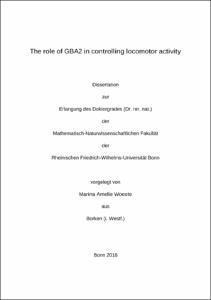Woeste, Marina Amelie: The role of GBA2 in controlling locomotor activity. - Bonn, 2018. - Dissertation, Rheinische Friedrich-Wilhelms-Universität Bonn.
Online-Ausgabe in bonndoc: https://nbn-resolving.org/urn:nbn:de:hbz:5n-52837
Online-Ausgabe in bonndoc: https://nbn-resolving.org/urn:nbn:de:hbz:5n-52837
@phdthesis{handle:20.500.11811/7681,
urn: https://nbn-resolving.org/urn:nbn:de:hbz:5n-52837,
author = {{Marina Amelie Woeste}},
title = {The role of GBA2 in controlling locomotor activity},
school = {Rheinische Friedrich-Wilhelms-Universität Bonn},
year = 2018,
month = dec,
note = {Glycosphingolipids are major constituents of cellular membranes, fulfilling both structural and functional roles. Modifications of the basic glycosphingolipid glucosylceramide (GlcCer) result in numerous complex glycosylated and sialylated glycosphingolipids, which are highly abundant in the central nervous system (CNS). Glycosphingolipid homeostasis is tightly regulated and the non-lysosomal glucosylceramidase GBA2 plays a central role as it hydrolyzes GlcCer to glucose and ceramide. Recently, mutations in GBA2 have been identified in human patients suffering from autosomal-recessive cerebellar ataxia (ARCA), hereditary spastic paraplegia (HSP), or Marinesco-Sjögren-like Syndrome (MSLS). How these mutations impair enzyme function and might cause locomotor dysfunction is not known. I could show that all these mutations beside one cause a complete loss of GBA2 activity, indicating that also the human patients potentially lack GBA2 activity. Detailed analysis of the structure-function properties of GBA2 revealed that its activity is encoded in the protein's tertiary structure, including the N-terminal domain, linker region, and C-terminal domain. GBA2 proteins interact and form oligomers, a characteristic that might also be crucial for enzyme function. However, in vivo experiments did not reveal severe locomotor dysfunction or morphological defects in the cerebellum in GBA2-knockout mice, pointing towards species-dependent differences in GBA2-regulated metabolism of GlcCer and GlcCer metabolites in the CNS. However, acute pharmacological inhibition of GBA2 in murine cerebellar neurons in vitro impairs neurite outgrowth, suggesting a potential mechanism how loss of GBA2 activity results in ataxia and spasticity in ARCA, HSP, and MSLS patients carrying mutations in GBA2. In vivo in the mouse, compensatory mechanisms might occur, preventing severe neurological manifestation after genetic loss of GBA2.},
url = {https://hdl.handle.net/20.500.11811/7681}
}
urn: https://nbn-resolving.org/urn:nbn:de:hbz:5n-52837,
author = {{Marina Amelie Woeste}},
title = {The role of GBA2 in controlling locomotor activity},
school = {Rheinische Friedrich-Wilhelms-Universität Bonn},
year = 2018,
month = dec,
note = {Glycosphingolipids are major constituents of cellular membranes, fulfilling both structural and functional roles. Modifications of the basic glycosphingolipid glucosylceramide (GlcCer) result in numerous complex glycosylated and sialylated glycosphingolipids, which are highly abundant in the central nervous system (CNS). Glycosphingolipid homeostasis is tightly regulated and the non-lysosomal glucosylceramidase GBA2 plays a central role as it hydrolyzes GlcCer to glucose and ceramide. Recently, mutations in GBA2 have been identified in human patients suffering from autosomal-recessive cerebellar ataxia (ARCA), hereditary spastic paraplegia (HSP), or Marinesco-Sjögren-like Syndrome (MSLS). How these mutations impair enzyme function and might cause locomotor dysfunction is not known. I could show that all these mutations beside one cause a complete loss of GBA2 activity, indicating that also the human patients potentially lack GBA2 activity. Detailed analysis of the structure-function properties of GBA2 revealed that its activity is encoded in the protein's tertiary structure, including the N-terminal domain, linker region, and C-terminal domain. GBA2 proteins interact and form oligomers, a characteristic that might also be crucial for enzyme function. However, in vivo experiments did not reveal severe locomotor dysfunction or morphological defects in the cerebellum in GBA2-knockout mice, pointing towards species-dependent differences in GBA2-regulated metabolism of GlcCer and GlcCer metabolites in the CNS. However, acute pharmacological inhibition of GBA2 in murine cerebellar neurons in vitro impairs neurite outgrowth, suggesting a potential mechanism how loss of GBA2 activity results in ataxia and spasticity in ARCA, HSP, and MSLS patients carrying mutations in GBA2. In vivo in the mouse, compensatory mechanisms might occur, preventing severe neurological manifestation after genetic loss of GBA2.},
url = {https://hdl.handle.net/20.500.11811/7681}
}






